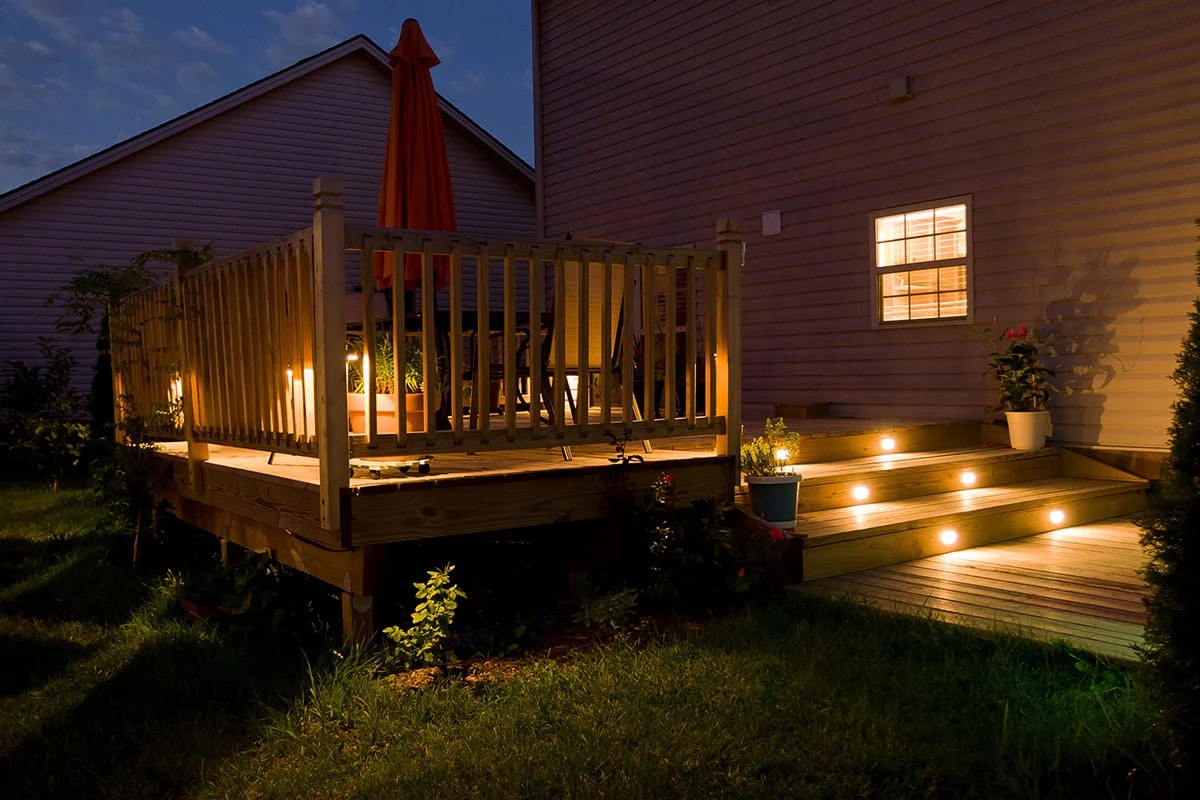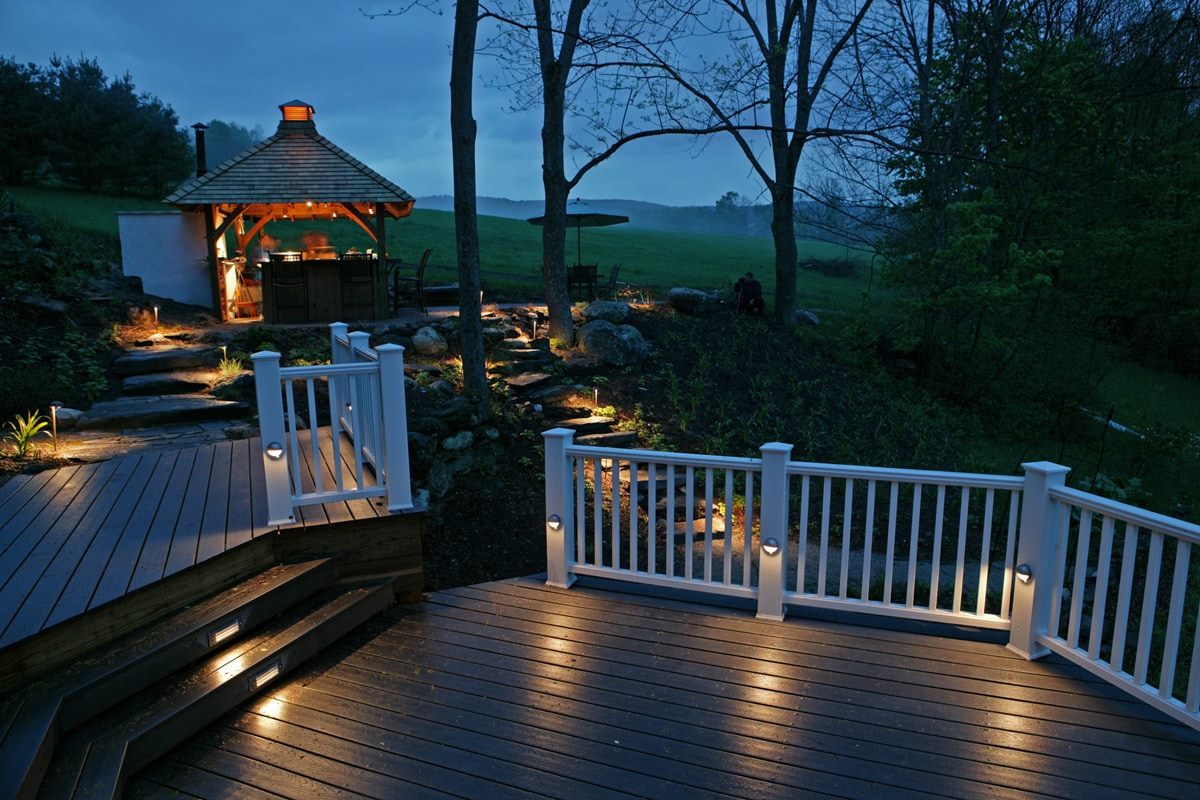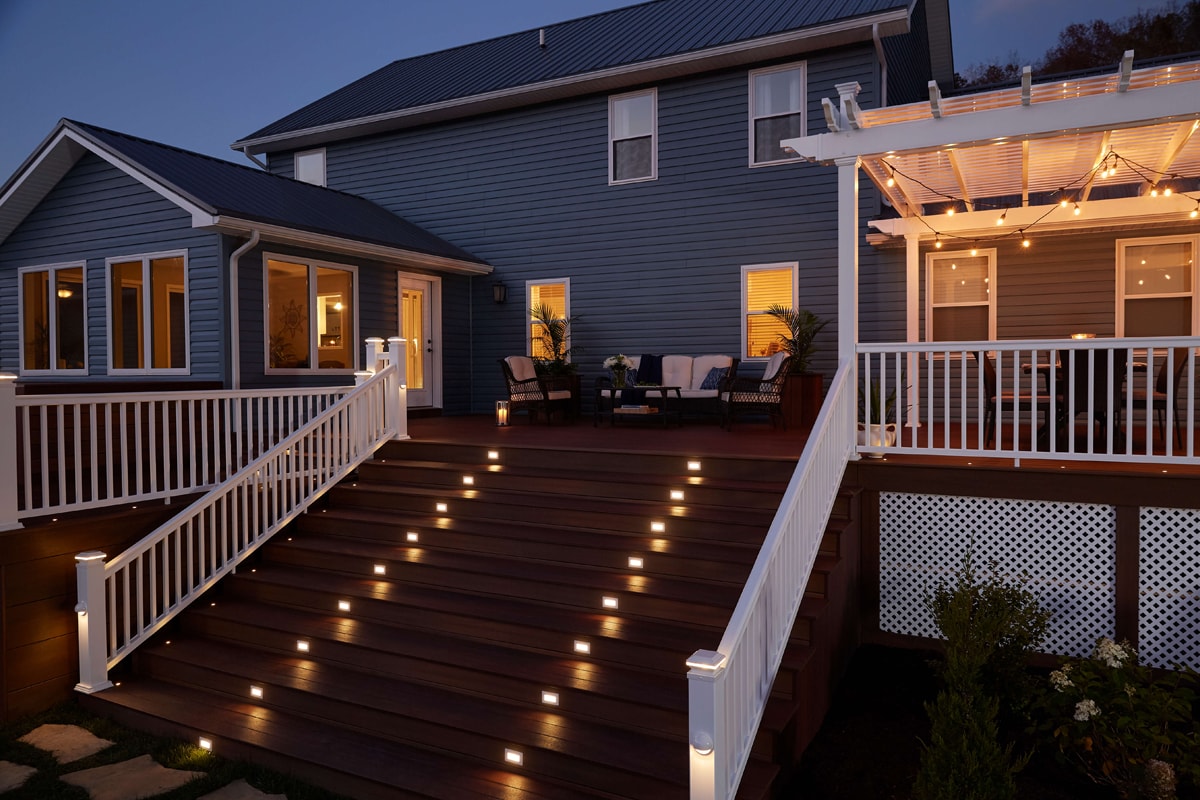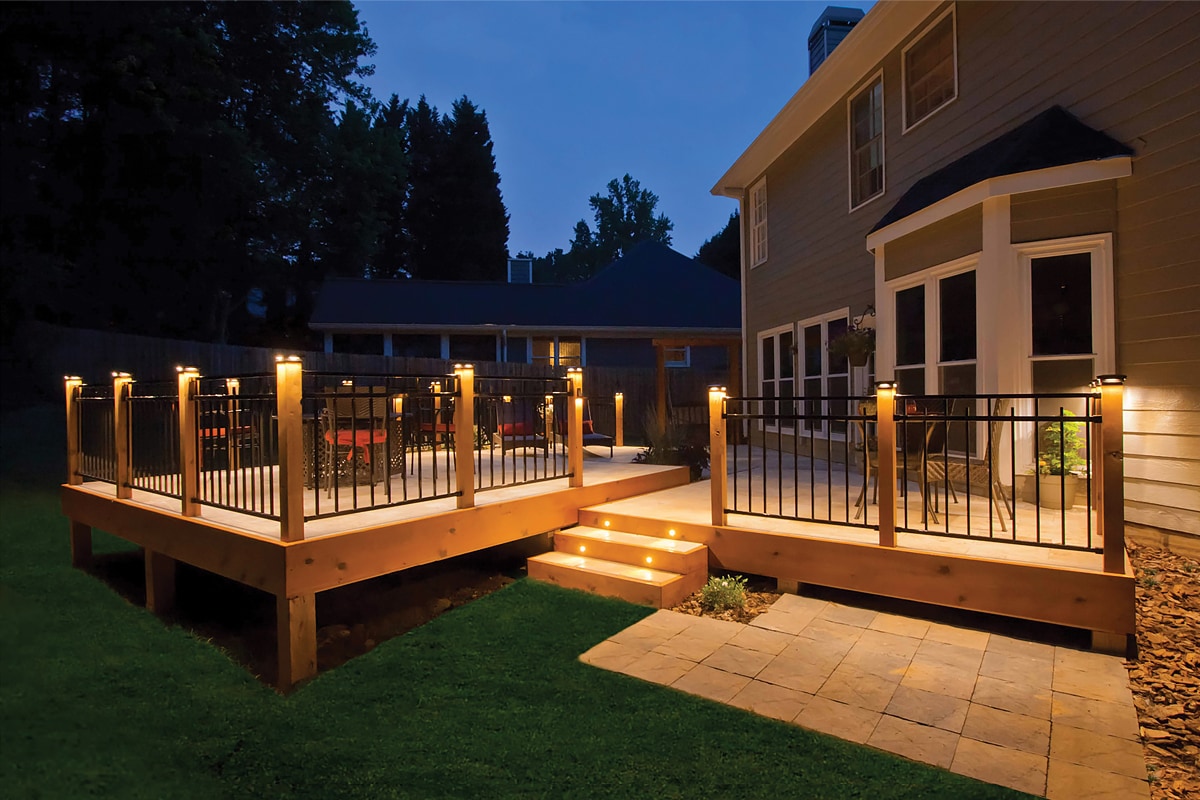There is perhaps nothing quite as magnificent as a beautifully set out decking area, complete with a planned and well-fitted set of deck lights. It can be as simple or as complicated as you like. The main thing to remember is to integrate your deck lighting ideas early before it is built. This will produce a more homogenous look to the whole deck area. I am not going to talk about how to install deck lighting here. That’s a whole different post altogether.
Now I am going into the ins and outs of the advantages and disadvantages of various types of outdoor deck lighting. If you are here, I am going to assume you want deck lighting anyway. If you are a newbie and you are not sure what deck lighting is and whether it suits you, then I will get some ideas and put it down very soon for you.
Types Of Deck Lighting
Well, this is where I could write and write if I wanted to and had enough space and time. But when it comes down to it, there are really only three basic types of deck lighting, the rest just being variations on a theme. I have split it up into your power options and the bulb type, as you first need to make a clear decision on this for your designs. There are so many arguments for LED deck lighting or low voltage deck lighting against solar deck lighting. I have made a rough comparison so you can see the main points as well.
Deck Lighting Systems
When I talk about systems, I want to look at this in two ways. First of all, how are you going to power your deck lights? Secondly, what types of bulbs are you going to use? Both of these will affect your power consumption and bills along with how you plan out your deck lighting design.
Choices For Power
For example, if you want to install low voltage deck lighting, there is cabling to think of and where the runs will go. They need to avoid areas where they might get damaged later. Then there are the low voltage transformers to locate as well.
Deck solar lighting is a lot easier as there are no cables, but will they get enough sunlight to power them up properly? I personally am hesitant about using solar power for any security lights around decking as I still have that fear factor of them running out of charge. Of course you can just get them on a motion sensor or simply buy a motion sensor solar light, so I might experiment.
Certainly though, I would use solar for pool decking lights. I have a morbid fear of any mains electricity anywhere near water, so I can’t even consider low voltage systems for this sort of application.
Overall though, don’t stress over low voltage as compared to solar power. The reality is a combination of the two is best. Get low voltage in for critical areas and solar in for where you want more freedom, you would suffer with voltage drop, or for safety reasons like near water or children.
Compare Solar And Low Voltage Deck Lighting
Solar Deck Lighting Systems
- Safety: No connection to electricity & no risk if water gets into the wiring.
- Flexibility: Easy to move around, take down and store for special occasions and to put up again. Either on or off. The only real control is with motion sensors.
- Running Costs: Free. The sun does not cost anything.
- Reliability: No moving parts as such, just the lights and a solar panel. Obviously if they are not charged properly, they can run out quicker.
Low Voltage Deck Lighting Systems
- Safety: Connection to the mains via extension lead is the greatest risk. Wired through a 12v transformer reduces the risks but they are still there.
- Flexibility: Need planning for your everyday needs. Have to plan where you need openings for deck lighting fixtures and cabling runs. It can be very controllable by using timers and dimmers.
- Running Costs: This depends on the voltage you run them on, the efficiency of your transformer and electricity costs per kwH in your area.
- Reliability: Very reliable if there is no power cut and water doesn’t get into the wiring.
Choose Between Low Voltage and Solar Deck Lighting
Part of the decision-making game when planning any deck lighting design is whether to go for solar deck lighting or low voltage deck lighting options. Each has there merits and supporters. Each has there advantages and disadvantages over the other. Now I am not here to definitely tell you to choose one over the other. Instead, let’s have a look at some of the basic principles and let you make your own choice based on the facts.
Safety of Deck Lighting
The safety of your deck area should be your number one consideration. For a start, there is the welfare of you, your family, and visitors to consider. Secondly, you have to think about meeting the various building code requirements. Finally, there is your liability and your insurance coverage to satisfy.
Now many homeowners out there worry about this and especially the chance of any outdoor solar deck lighting failing. Failing that usually means the fear of the solar-powered deck lighting running out of the charge that has been built up in the daylight hours. Now, this would be rare, providing the panel was exposed enough, but it could happen. Low voltage deck lighting does not have this worry, except in the event of a power cut.
The Costs of Installing
Let’s consider a new installation. If you go for a low voltage deck lighting installation, then things are a lot more costly and complicated. There is the issue of voltage drop to calculate and account for. Then there is planning all the wiring and where it will go safely. Finally, you have to think of what type of low voltage transformer you will choose and where you will site it. All of these tasks are a job for any experienced and certified electrical contractor, who will cost money. All of the equipment will also cost you extra cash from your budget.
With solar deck lights, there is none of these issues and costs. Installation is very simple, and the chances of being denied approval or insurance are a lot lower. After all, if you have no wiring, there is no chance of electrical shock, short outs, or fire.
The Costs of Running
This is a complete no-brainer. The calculation is very simple. Deck solar lighting is free to run. That’s an easy fact, powered as it is by the sun. Not even the Federal or State government has found a way to charge me for using the sun yet. On the other hand, although lower voltage and power drain than your main house electricity, low voltage outdoor deck lighting still costs money. When you add up all your fittings over the course of one, two, or five years, it is still money you might prefer to have rather than spend on lighting.
A Solution to the Power Problem
My solution is simple and really marries the two power options together. For critical areas of safety or for security, install a limited low voltage deck lighting arrangement. This could consist of outdoor wall lights and maybe some of the step lights that you will need on your deck built by law. By reducing the amount, you simplify the amount and costs of wiring, transformers and avoid voltage drop problems. You also get the peace of mind you need over important areas. If you keep things small in this portion of the deck, lighting low voltage fittings are not such an issue to you or your insurers.
Then for the rest of the deck lighting solar powered options can be easily used without worry. This will give you more flexibility overall and allow easier extension at a later date.
Of course, this is just my take on the whole argument, but I think it s a sensible and practical approach to what is a much debated problem when building a lighting design for a deck in your backyard or garden.
Light and Bulb Types
I am a big fan of LED deck lights. I really don’t see the benefits of incandescent bulbs outside. It’s how I started, but no longer. It could have something to do with the fact that I am particularly clumsy and was forever burning myself when changing them. I always forget that any glass surround needs to cool down first. I have lost count of the number of times I have dropped them as well. So for me LED deck lighting is the tops. You can have a look at the post I wrote about LED deck Lights here. But, I would summarise why I use deck LED lighting as follows:
- Use a lot less power.
- This is really good for my bills and also makes the solar powered LED lights last a lot longer.
- LED bulbs do last so much longer. This saves me money and the hassle of changing them or keeping them in the basement ready.
- LED lighting systems don’t just burn out on me. I get a warning as they dim. It comes back to bulbs again. I don’t have to buy just in case.
- Gives me a good feeling that because of the above, they are pretty good environmentally. I like to do my bit without going mad. But I always ensure I get the mercury-free ones.
Of course, as they are also brighter, you need to be aware of your light pollution and nuisance to neighbors. Just always think a bit of others as well, and it makes life go just that bit smoother.
Designing and Buying Deck Lighting
This gets down to the real core of things, that’s money. There is tons of choice out there for your deck lights, and there are lots of manufacturers, materials, and prices. For me, get a deck lighting design together before you do anything. I have seen friends really mess things up because they didn’t, and it’ll cost them upwards of 20-40% extra.
If you get a good design, you will have your shopping list ready-made. The number of lights, transformers, cabling requirements, clips, tools, drill bits, etc.
Optimize your spending by buying kits. Good solar or low voltage deck lighting kits can give much better value overall. You will also be able to get a more uniform look over the deck area. The same applies to sticking to one manufacturer for the bulk of the functional items. The key note or accent lighting items can be sourced individually.
For the same reasons, buy your low-voltage cable in bulk and get about 10-20% more than you need. You can deal with any mistakes, unforseen detours and leave yourself with a bit of spare as well. Buy from a reliable source with cheap shipping and a good and clear returns policy if you do it online. Buying more cable also means you have some spare to make adjustments, alterations, or if you add to the design later.
Tools For Installing Exterior Deck Lighting
Make sure you have the right tools to do the job, especially where power tools are concerned. You should be looking at a good and reliable brand like Milwaukee or De Walt. If you want to get a cordless drill, then get a spare power pack, so you always have one on charge. My personal choices and best selections are below.
I nearly always buy from Amazon. They have the best selection every time and definitely the lowest power tool prices and best shipping. I have looked elsewhere, and even the discount online stores can’t match them. The links are below, so check for yourself. These are the best-rated drills in their class as of today. All 4 & 5 star reviews.
- Milwaukee Electric Tools 2598-22 M12 Fuel 2 Pc Kit- 1/2″ Hammer Drill & 1/4″ Impact
- DEWALT 20V Max Cordless Drill / Driver Kit, Compact, 1/2-Inch (DCD771C2)
Low Voltage Cable
Of course, if you are not using solar deck lights, then you are looking at a low voltage lighting system. That requires proper cabling and routing under and around your decking and deck lighting fixtures.
Now please, please make sure you get the length you need right. Unit price wise cabling doesn’t seem too bad, but when you start having to get 40, 50, or 100m plus, it adds up. Of course, you will also need a low voltage transformer as well. Read the reviews and you will see why they are so popular.
Highly rated 12/2 cable, self-sealed, weatherproof and easy to install. A great advantage in that the cable is that it doesn’t have to be taped over. 100 feet of quality.
Transformer
The best and most frequently rated low voltage lighting transformer. Comes in 200W as well and a 5 year limited warranty, which sounds pretty good to me.
Deck Lighting Fixture Options
Now, this is where we can open a whole can of big worms! There are lots of types of fixtures and options, and different manufacturers have different names for the same thing. It is designed to try and confuse us as buyers.
Are they post lights, downlighters, step lights, or deck post lights?
So I am going to try and keep it generic, with a few tweaks here and there, first of all, the ‘meat on the bones’ with deck post lighting, then the essential deck step lighting.
Deck Post Cap Lights
As the name says, they sit on top of your main decking posts. While most are simple, decorative, and functional, you can get some fantastic models of deck post cap lights that make excellent focal points. Personally, I love the classic look and also the lantern style post lights.
But there are post cap lights for everyone, including stained glass and also modern and contemporary designs as well.
Deck Post Lights/Downlights
When I talk about deck post lights, I mean the more discrete downlighters that usually sit near the bottom of the deck lighting post. They direct their light down and are quite low powered. The function is not to light up the decking but mainly to provide suitable light at foot level to be able to make steps, stairs, and perimeters safer. Of course, by doing this with a lovely diffused light effect, they also set a lovely subtle atmosphere as well to the areas they are in.
The best deck post lights will be hardly noticeable and many designs are very functional. You can get more adventurous or classic designs as well and Kichler deck lighting seems to excel in this area with an extensive range of low voltage deck lighting for posts. The Kichler deck post lights mainly come in metal, with various patinas or burnish applied. But occasionally, you do find something a little different with their downlighters. I found these rather lovely lizards, which are very different and could look very different as part of a landscape lighting design incorporating your deck lighting
Deck Step Lights
Deck step lights are essential for the safety of your family and guests, and you will also find that they play a vital part in satisfying your building code regulations. You need to check your local state requirements when designing deck lighting.
Usually sitting in the stair riser, they light up any stairs and steps to prevent accidents. However, if you choose right, they can also produce wonderful displays. I have seen some great effects with steel circular step lights on a curving stair. This is where we get a crossover in naming as well, with what I would class as post lights/downlighters included as well.
Styles vary of course, but the Louvre style are very subtle and popular, functioning as step lights as well as downlighters. As with all deck lighting, the material and style you go for should ideally form a theme across the decking area.
Recessed Deck Lighting
Recessed deck lights are exactly what they sound like. They are either inset slightly or flush with your decking floors, which is where they are mainly used. Fitted like this, they are perfect in heavily trafficked areas or where safety is an issue, such as around pool areas. As they are flush mounted, they don’t become a trip hazard. But, you can use them in other places where the discrete recessed deck lights look great. I have seen them used on bench ends, in stairs and steps, or embedded into walls and constructions.
Generally, these deck lights are fitted to light upwards, so a smoked or opaque lens is recommended to diffuse the light properly, so deck users aren’t dazzled by them. Do remember to buy only those with flat and not dished lens tops as well. Otherwise, they are going to collect water. For durability and corrosion resistance all in one, it is hard to beat stainless steel recessed deck lighting. Plastic can be used, but don’t expect it to last as long. It also has a tendency to discolor in UV light. I personally would always also go for LED recessed deck lights. They don’t heat up like incandescent bulbs, so they are safer where bare feet are around.
Those are the three main deck lighting areas really. There are plenty of variations on a theme though, and we will need to look at cheap deck lighting, where to buy deck lighting, the best deck lighting, and who makes the best deck lighting, but those are in the pipeline for future posts, so subscribe to my feed and keep up to date.









